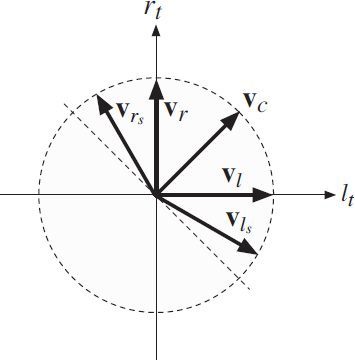2.4 Matrix surround
Matrix systems enabled wide spread use of surround sound. First in movie theaters as Dolby Stereo and later in homes as Dolby Surround [129]. One reason for the success of matrix systems is its stereo backward compatibility. Matrix systems ‘encode’ multiple audio channels into two stereo compatible audio channels. Given a matrix encoded stereo signal, a matrix decoder is applied to approximate the original multi-channel audio signal.
Early matrix systems were used to encode four audio channels into a stereo signal, denoted 4-2-4 systems [75]. Modern matrix systems, such as Dolby Prologic II [69], are capable of encoding 5.1 surround audio signals, if desired, including the LFE channel. More recently, also matrix systems for 6.1 and 7.1 signals have been introduced (e.g. Dolby Prologic IIx).
Figure 2.12 The vectors for encoding the five main channels of a 5.1 signal to two channels.
In the following, a simple 5-2-5 matrix system is described for encoding the various channels of a 5.1 surround audio signal. The audio channels are encoded as

where lf(t), rf(t), c(t), ls(t), rs(t) denote the front left, front right, front center, rear left, and rear right audio channels, respectively. The j denotes a 90° phase shift.
Alternatively, (2.3) can be written as

where the five vectors are unit vectors mapping the five input channels to the two output channels. The vectors are shown relative to lt(t) and rt(t) in Figure 2.12.
The simplest way of decoding a matrix encoded signal is to apply a ‘passive decoder matrix’. Formulated in terms of the previously defined vectors, the matrix decoded channels are:
Each output channel is equal to the projection of the matrix encoded signal onto the corresponding matrix encoding vector.
As can easily be verified, the described encoding/decoding strategy perfectly reconstructs a channel in a scenario where only a single channel is active. However, the other channels are not zero in this case, i.e. there is a lot of crosstalk. The situation when only one channel is active can easily be detected. In such a situation one could set all the other audio channels to zero and thus improve the channel separation. This is the principle idea behind ‘active matrix decoders’ [106].
Often the rear channels of matrix systems are low-pass filtered and delayed. The lowpass filtering mimics late reverberation which has high frequencies attenuated due to more absorption of sound in air at high frequencies. The rear channels are delayed to prevent that signal components are ‘jumping’ between front and back when the matrix decoder can not well separate the channels. Due to the precedence effect (Section 3.4.1) front/back correlated signal components will always be perceived from the front if the back channels are delayed. It is especially important for dialogue in movie sound tracks to firmly always stay in front.
While very practical, since matrix surround enables multi-channel audio, based on a stereo down-mix, matrix surround provides only very limited surround sound quality. For most surround sound material with multiple concurrently active sources and ambience, matrix surround impairs the audio quality in terms of a loss of ambience (due to loss of channel independence) and limited localization (due to high channel crosstalk). Spatial audio coding achieves much higher audio quality by means of ‘guided’ up-mixing of the down-mix to the original number of channels. The quality of Spatial Audio Coding is more like discrete surround than matrix surround.


